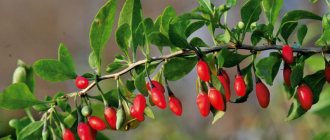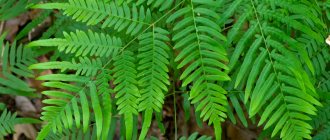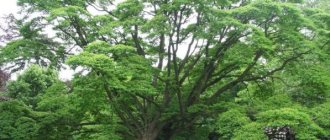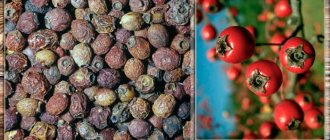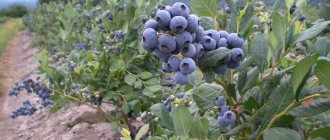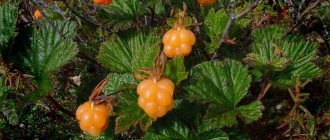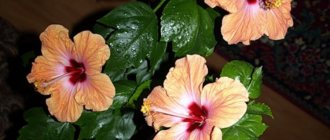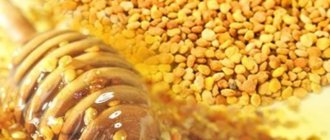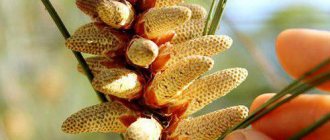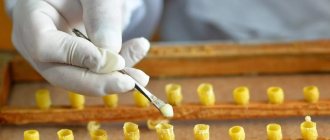History of the plant
The first mentions of fruits that are practically unique in composition go back to England. In the 18th century, the shadberry plant came to North America. There, its berries quickly gained popularity due to their unusual taste. They were used to prepare sauces for wild meat, mixing with lemon and rhubarb. The fruits were also used to prepare jams.
As soon as its popularity reached the masses, the plant began to be cultivated on a production scale, dedicating entire plantations to plantings. In the countries of North America and Asia Minor, shadberry is still grown for subsequent sale. Although it can often be found in garden compositions as a decoration.
The plant came to Russia a century later. At first, its fruits were sold at fairs under the guise of grapes. And only Michurin began to propagate the irgu, thereby contributing to its spread.
Use in cosmetology
The plant is used to care for skin and fight wrinkles.
- Masks can be made from berries alone or in combination with cream, honey and aloe. For oily skin, clay, tea tree oils, lemon juice and herbal infusions will be a good addition to shadberry.
- Pieces of ice made from a weak berry decoction have an excellent tonic effect. They eliminate puffiness and bags under the eyes, help narrow pores, and refresh the skin.
Before preparing cosmetics, it is necessary to remove the coloring top layer of the berries.
Benefit
The healing properties of the berries are explained by their rich chemical composition. They contain a high content of the following microelements and vitamins:
- copper;
- iron;
- cobalt;
- vitamins B and C;
- beta-carotene;
- cellulose;
- pectin.
Among the useful substances one can note coloring and tannins, anthocyanins, organic acids, flavonols, and catechins. Their concentration and combination contribute to the body’s fight against numerous diseases. And the antioxidant content effectively prevents the growth of cancer cells.
Since the calorie content of the fruit does not exceed 45 kcal, their consumption does not harm the figure and is acceptable even with a strict diet
Table of useful substances in the composition of currant berries:
| Vitamin C, mg% | 26,15 |
| Vitamin P, % | 0,44 |
| Flavonoids, mg% | 514 |
| Anthocyanins, mg% | 560 |
| Tannins, % | 2,06 |
Useful properties of irgi:
- Strengthens the immune system.
- Eliminates stomach upset.
- Relieves the symptoms of gastritis.
- Relieves nervous tension and improves sleep.
- It has an anti-inflammatory effect and effectively helps with sore throats, even purulent ones.
- Reduces pressure and improves the condition of blood vessels.
Tinctures made from serviceberry berries have an excellent healing effect. When used externally, the blood quickly stops, but this does not affect the liquefaction of the connective tissue. Regular consumption reduces the risk of thrombosis.
Beneficial properties of berries, leaves and flowers of serviceberry
The rich chemical composition explains the rare value of the berry. You will be surprised that the unpretentious shadberry was not immediately appreciated. But when people “saw through” its valuable properties, all parts of the plant were included: dried berries, leaves, flowers, bark.
Juice
Iga has quite a lot of tannins, so the berry is slightly astringent. Squeezed juice, especially together with game juice (wild plums, apples), gives excellent results for the treatment of throat diseases and is partially effective in the treatment of gastric disorders. Compote with decoctions also has the same properties, but in a slightly lower concentration. To do this, the berries are boiled with sugar or honey in clean water and allowed to brew.
Fresh and dried fruits
The astringent properties of serviceberry are preserved in dried and frozen form, which is why folk craftsmen make marshmallows, jelly from the berries, and simply dry the berries, like rowan berries, blueberries, and currants.
In winter, dried serviceberry berries are boiled to obtain a healing infusion for the treatment of colds and simply the prevention of acute respiratory infections and acute respiratory viral infections.
Now, during the fashion for a healthy lifestyle, supporters of a raw food diet have fallen in love with berries. They are sure that nothing better than Karina cleanses the body of carcinogens, waste and toxins, which stops aging. Thanks to fructose, the berry helps replace sugar, albeit temporarily, turning into the basis for hearty and healthy smoothies during a detox diet. To do this, shadberry is mixed with celery, green apples, mixed with strawberries and pears. A hearty and healthy option is a mixture of serviceberry with low-fat cottage cheese. This berry mousse can easily replace dinner.
Leaves and flowers
The leaves and flowers of the plant are collected during the season. The delicate inflorescences of the serviceberry have such an inexpressible taste that pleasant and light soothing teas are brewed with them. It is believed that drinks help relieve fatigue after a hard day and prevent depression. In winter, hot teas with berries are good, and in summer, such drinks relieve the desire to drink and fill the body with a pleasant feeling of relaxation.
Bark
Serviceberry bark is considered the number one product for treating inflammation, skin rashes and even heart disease. To do this, the bark of the serviceberry is collected, placed in paper or linen bags, and then tinctures are made from them in water or alcohol. The bark is used to treat skin lesions and ulcers, in emergency cases it stops bleeding and disinfects it no worse than plantain, especially if there are no medications at hand.
The bark and leaves of irgi have medicinal properties if used simultaneously.
Extracts from them soothe spasms in the stomach and intestines, gently enveloping the internal organs, softening irritated mucous membranes. In this capacity, weak bark tea with the addition of mint and a small spoon of natural honey is especially useful.
Harm and contraindications
In addition to its benefits, irga can also cause harm. If a person has low blood pressure, it is better to limit the consumption of berries by consulting with your doctor in advance. There are no more strict contraindications if you follow the measure. Even medicine can turn into poison if overdosed.
Harmful properties:
Properties of chokeberry
- Decreased blood pressure - in the case of hypotension, the positive effect takes on a negative effect. As a result, berries can provoke a feeling of disorientation in space, and exceeding the dose often ends in loss of consciousness.
- Blood thinning. If a person suffers from this condition, it is better to avoid consuming shadberry, especially when work involves an increased risk of injury.
- Development of food allergic reactions. They do not proceed at lightning speed. Most often, a negative condition manifests itself as a sore throat. In rare cases, allergy sufferers experience swelling of the mucous membranes of the respiratory organs.
Attention! Diabetics are not prohibited from eating berries, but only in combination with foods that have a lower glycemic index.
Women carrying a child should not include such a delicacy on the menu. The problem is tannins, which can cause poor digestibility of food. The result is constipation and indigestion. The ban also applies to the period of breastfeeding, since shadberry is an allergen. The child may develop a rash and itching.
Chemical composition
Corinka is a low-calorie dietary product, 100 g of which contains 45 calories. The energy ratio B: F: Y is 0: 0: 100%.
The fruit contains:
- ascorbic acid (40%);
- sugar (12%);
- flavonoids (2.5%);
- pectins (up to 1%);
- organic acids (1%);
- carotene, coloring components, fiber (up to 0.5%).
The bark and leaves of the bush contain tannins, and the seeds contain fatty oil.
Irga is a source of phenolic compounds; per 100 g of berries there are:
- leukoanthocyanins and anthocyanins (896-1607 mg);
- catechins (106.1-281.9 mg);
- flavonols (127.3-339.8 mg);
- chlorogenic acids (163.8-258.8 mg).
100 g of product contains 0.4 mg of carotene, 7.5 mg of ascorbic acid and up to 12.5 mg of riboflavin. Manganese, iodine, copper, lead, and cobalt were found among macro- and microelements.
Botanical description
Irga is a unique crop that grows quickly and produces a harvest every year. It is often used as a garden ornament because of its abundant flowering, beautiful fruits and exquisite leaf color in autumn. Leaf blades with jagged edges can be round (round-leaved species) or oval. During the period of intense growing season, like many tree-like crops, their color is green. They are darker on top and lighter below. But in autumn the crown looks very impressive, turning crimson.
During the flowering period of irgi, racemose inflorescences form at the ends of branched shoots
The flowers are white or cream, depending on the variety. One pestle. Ovary inferior. Abundant flowering and fruiting are observed on last year's apical shoots.
The shape of the fruits formed after successful pollination is similar to small apples. Diameter - 1 cm. The berry is called “irga” or “yurga”, which is correct in both cases. The purple or blue-black skin is covered with a bluish coating. The pulp is sweet, aromatic and juicy. Due to these qualities, the fruits are used as wine berries.
The phase of mass fruiting occurs in the second half of summer. The harvest period is extended, which makes harvesting difficult. It should be carried out at regular intervals as the berries ripen.
Growing
It is recommended to plant shadberry in spring or autumn in a bright place for abundant fruiting of the plant. Otherwise, her strength will be spent on stretching shoots in search of light. Irga is not capricious; it loves fertile soil (sandy or loamy), but can grow in any soil. Acidity does not matter. It is not recommended to plant the plant in areas where groundwater is high, since its root system extends 2.5 m into the soil.
Before planting, the area is cleared of weeds, dug up, phosphorus or potassium fertilizers are applied (40 g per 1 m2), and kept under black fallow. Digging depth – 15 cm.
Serviceberry seedlings are placed in a checkerboard pattern, maintaining a distance between bushes of 0.5-1.5 m. The size of the hole is 60x60x50 cm. Planting of currants is done according to the principle of berry plants: blackberries, blueberries, actinidia, gooseberries, currants, raspberries, honeysuckle.
Remember, the root collar of a serviceberry seedling cannot be buried.
After planting, the bush is generously filled with water to shrink the soil (8-10 l), after which soil is poured into the hole to level the surface of the area. In order for the plant to take root, the soil around the serviceberry is mulched with peat and humus. After planting the bush, 5 developed buds are left on each shoot, and the rest of the above-ground part is cut off.
Irga is easy to care for. To get a bountiful harvest, it is enough to regularly weed the weeds around it and rarely water it. Occasionally apply seasonal fertilizers and trim the bushes.
Irga is drought-resistant; watering is required only during the driest season. It is better to do this in the afternoon - after 16.00, when the heat subsides.
After four to five years of age, every year, fertilizers (2 buckets of humus, 200 g of potassium and 300 g of superphosphate) that do not contain chlorine are applied to the tree trunk circle, retreating 25 cm from the root collar. From April to July, it is recommended to feed the shadberry with liquid organic matter - a 10% solution of chicken manure (5 liters per bush). Apply overnight to pre-moistened soil (after rain or watering).
It is better to trim the currants as rarely as possible, as needed.
To do this, follow the following rules:
- Start pruning in the 2-3rd year of the plant’s life in early spring, before sap flow begins;
- plant shadberry in a sunny area to allow light to penetrate into the thick of the bush;
- trim only short varieties of currants.
Vertical shoots of young bushes should be shortened by ¼ of last year's growth. In the future, prune the side branches. This will stimulate the crown to grow wider. Otherwise, there will be difficulties in harvesting from a tall tree. It is recommended to treat sections of adult branches with oil paint on drying oil. And on annual shoots you don’t need to lubricate. Do not forget to deal with dry branches and root shoots that thicken the bush. Trim them to the stump.
Species diversity
Irga is a representative of the Rosaceae family. The genus has 18 species. Some can be found in the wild in Russia. However, the majority are native to North America. Popular species that formed the basis for obtaining garden varieties.
Oval-leaved
The plant has small fruits with an almost bland taste. The name of the species is due to the shape of the leaves. An interesting feature of the species that sets it apart from others is the flower. In the type variety, the pistil columns are completely free, while in other species they are almost half fused.
Although the berries of the oval-leaved karinka are not distinguished by their bright taste and juiciness, cultivated varieties have been bred on its basis. Growing them does not require much time and effort, so shrubs are often used for decorative purposes. The Helvetia variety is a perfect example of this. It is valued for its lush flowering and low stature. Often planted along sidewalks. Another striking representative of the species is “Edelweiss”. Its height can reach 3 m.
How to spell correctly, the emphasis in the word “irga”
Making the Word Map better together
Hello! My name is Lampobot, I am a computer program that helps you make Word Maps. I can count perfectly, but I still don’t understand very well how your world works. Help me figure it out! Thank you!
I will definitely learn to distinguish widely used words from highly specialized ones.
How clear is the meaning of the word Odessa
(noun):
Synonyms for the word "irga"
Sentences containing "irga"
Associations to the word "irga"
The meaning of the word "irga"
Irga, or Corinka (lat. Amelánchier) is a genus of plants of the Maleae tribe of the Rosaceae family, a deciduous shrub or small tree. (Wikipedia)
Submit Comment
Additionally
The meaning of the word "irga"
Irga, or Corinka (lat. Amelánchier) is a genus of plants of the Maleae tribe of the Rosaceae family, a deciduous shrub or small tree.
Sentences containing "irga"
From serviceberry berries
cook the jam by adding a little citric acid.
The fruits ripen about a week later, purple-black, with a bluish tint, edible, taste like serviceberry
round-leaved.
The plant is exceptionally frost-resistant and winter-hardy, so Irgu
can be used to protect the garden from the wind by planting it as a fence along the northern border of the site.
Source of the article: https://kartaslov.ru/%D0%BA%D0%B0%D0%BA-%D0%BF%D1%80%D0%B0%D0%B2%D0%B8%D0%BB%D1 %8C%D0%BD%D0%BE-%D0%BF%D0%B8%D1%88%D0%B5%D1%82%D1%81%D1%8F-%D1%81%D0%BB%D0 %BE%D0%B2%D0%BE/%D0%B8%D1%80%D0%B3%D0%B0
Nuances of using berries
Healing infusions can be prepared from both fresh and dried fruits. Therefore, you can harvest raw materials for future use by drying them in the shade. An infusion of berries is prepared from one tablespoon of berries and a glass of boiling water. The mixture is infused for about half an hour and then drunk. The infusion is great for stomach upsets.
Edible serviceberry bushes are an excellent solution for arranging a garden. The plant will perform several functions at once (decorative and practical), producing an abundance of tasty and healthy fruits.
Serviceberry berry - harvesting for the winter
You can pick the berries in several stages - they do not ripen at the same time. The leaves of the bush are harvested in May, the berries as they ripen, and the bark is collected in the fall. Infusions are prepared from fresh berries; you can also use dried ones - the beneficial qualities of the serviceberry will appear more fully.
What can be prepared from shadberry - recipes
If the berries have grown, it means you can cook something from them! Cook compote, adding other berries, jam, marshmallow. Prepare some fruit juice, or maybe you want to try wine made from healthy berries? In order to preserve the beneficial benefits of shadberry during culinary processing, you need to follow several rules. I bring to your attention several recipes.
You will find more recipes by following the link in the article “What to cook from serviceberry.”
Serviceberry jam
According to tradition, it is more common to make jam, it can be stored for a long time, you can drink tea, and use it in baking.
Recipe for jamberry jam for the winter:
- Sort the berries, wash, blanch for 2 minutes in boiling water.
- Prepare sugar syrup: for 1 kg of berries you need to take 400 g. Sahara. Bring the berries to a boil in the syrup, remove and leave to steep for 12 hours.
- When finishing cooking the jam, add citric acid to it (1 gram per liter of jam). The jam will be tastier if prepared with black and red currants.
If you like mashed berries, keep in mind that they do not store well in the refrigerator - they are too sweet.
Serviceberry juice
Jam is a good thing, but you will agree that few beneficial properties are retained during long-term heat treatment. I suggest making juice, and if you prepare it according to the rules, you will get enormous benefits for your body.
- To get a tasty juice, first hold the berry a little in the sun - this will increase its sugar content and the aroma will appear.
- The juice is incredibly sweet; for a little sourness, add red currant juice to it in equal proportions.
- The juice is heated to a temperature of 85 degrees and sealed in bottles.
Fruit juice from serviceberry
Fruit juice from serviceberry will perfectly quench your thirst. First, squeeze the juice from a glass of berries, boil them together in a small amount of water. Put half a glass of sugar into the strained broth and add water to make a liter of liquid. Let it brew for a day, store in the refrigerator.

